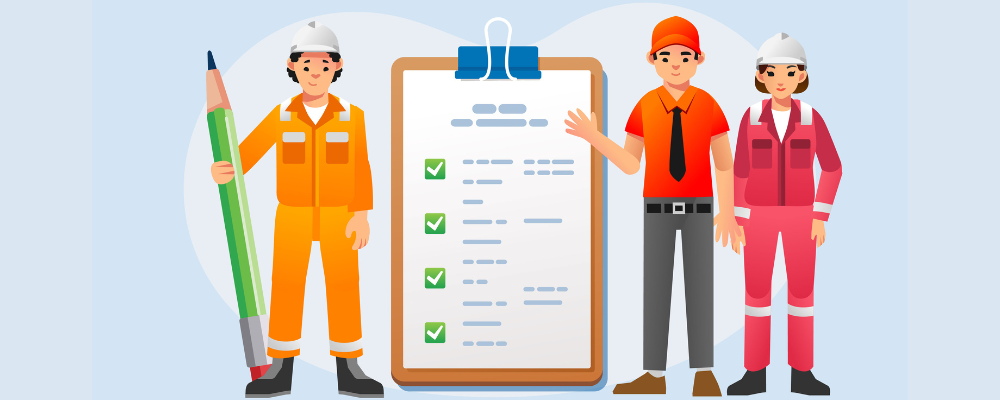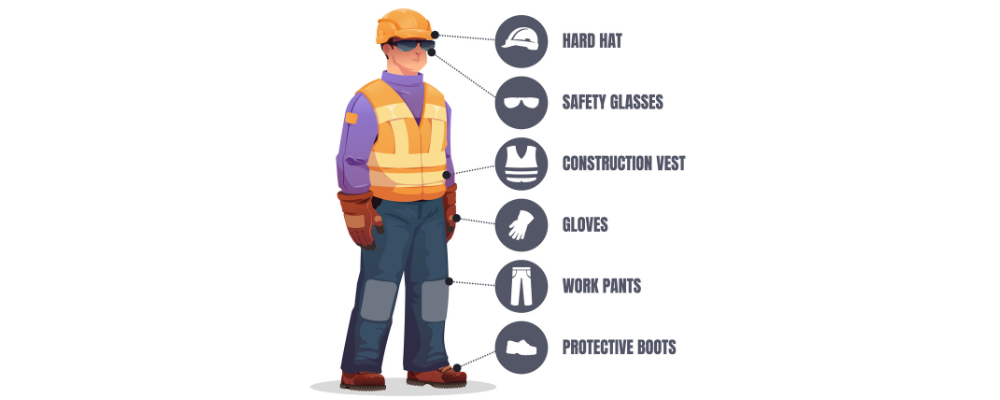
Introduction
Construction sites are veritable hubs of productivity but come with inherent risks that demand meticulous safety protocols to ensure the well-being of workers. Delving into crucial safety tips tailored to empower construction professionals within these bustling environments becomes paramount. These measures equip them with the knowledge and resources to mitigate potential hazards effectively.
Understanding the Risks
Construction sites are dynamic and rife with diverse hazards that demand acute awareness. The risks are multifaceted, from working at precarious heights to maneuvering heavy machinery. Understanding these dangers is the cornerstone for proactive risk reduction strategies, fostering a safer working environment for all involved.
1. Personal Protective Equipment (PPE)
The bedrock of safety within a construction site lies in using Personal Protective Equipment (PPE). This gear is not simply recommended but rather non-negotiable for workers’ safety. The right PPE acts as a shield against various occupational hazards:
- 3XL DISP COVERALL W/HOOD E/W/A: This indispensable coverall provides not just adequate coverage but also ensures a proper fit, thereby shielding against dust, chemicals, and other contaminants that pose threats to skin and respiratory health.
- BOX R Plug Corded Earplugs NRR 32dB and ANSI Certified: Amidst the incessant clamor of machinery and tools, these earplugs become a crucial asset. With a Noise Reduction Rating (NRR) of 32dB and ANSI certification, they offer optimal hearing protection, ensuring workers can perform their tasks without compromising auditory health.
- FLANGE Ear Plugs: Specifically designed to block high noise levels, these earplugs prioritize auditory health in high-decibel environments commonly found on construction sites.
- Equipping oneself with the appropriate PPE is not just regulatory compliance but a proactive measure to safeguard against potential health risks prevalent within the construction milieu.
2. Height Safety
Working at elevated heights is an integral yet perilous aspect of construction. Safeguarding against potential falls demands a comprehensive approach to height safety. Prioritizing safety measures is paramount to ensure the well-being of workers on-site.
-
Harnesses:
Harnesses serve as a lifeline for workers operating at elevated levels. Ensure the correct fit and proper attachment to sturdy anchor points. Regular inspection of harnesses for wear and tear is crucial to maintain their effectiveness. Workers should be adequately trained in harness usage, including proper donning and adjustment.
-
Guardrails:
Guardrails act as a preventive barrier against falls. Install sturdy guardrails along open edges, platforms, and stairways to provide a physical barrier and reduce the risk of accidental slips or trips. Regular inspections are vital to ensure guardrails remain intact and functional.
-
Scaffolding:
Properly erected and secured scaffolding provides a stable working platform at heights. Ensure scaffolds adhere to safety standards, including adequate planking, guardrails, and stability. Regular inspections and maintenance of scaffolding components are imperative to identify and rectify potential hazards promptly.

-
Fall Arrest Systems:
Implementing fall arrest systems, including safety nets and personal fall arrest systems (PFAS), provides an added layer of protection. PFAS, comprising harnesses, lanyards, and anchorage points, arrest falls should a worker slip or lose balance. Regular inspection and maintenance of these systems are essential for their reliability.
-
Training and Compliance:
Thorough training on height safety procedures is indispensable. Workers must be well-versed in adequately using safety equipment and techniques for working at heights. Compliance with safety standards and regulations should be strictly enforced, ensuring adherence to best practices.
-
Risk Assessment and Communication:
Before commencing work at elevated heights, conduct a thorough risk assessment. Identify potential hazards and communicate them effectively among the team. Clear signage and communication regarding restricted areas or potential dangers aid in preventing accidents.
-
Ongoing Monitoring and Improvement:
Continuous monitoring and improvement of height safety measures are vital. Regular audits, feedback mechanisms, and updating safety protocols based on new insights or incidents contribute to a safer work environment.
Height safety is a non-negotiable aspect of construction work. Prioritizing safety measures such as harnesses, guardrails, and scaffolding significantly reduces the risk of falls and ensures a secure working environment for all workers. By integrating these measures into daily practices and fostering a safety-oriented culture, construction sites can effectively mitigate the risks associated with working at heights.
3. Equipment Safety
In construction, tools and machinery are the backbone of productivity. However, their efficient and safe use hinges upon rigorous inspection and maintenance. Here’s a detailed breakdown:
-
Regular Inspections:
Routine inspections are indispensable. Ensure that tools and machinery are checked before and after each use. Look for signs of wear, tear, or damage that might compromise their functionality or safety.
-
Guidelines Adherence:
Abide by the manufacturer’s guidelines for proper usage and maintenance. These guidelines often encompass specific instructions on use, maintenance schedules, and recommended safety measures. Deviating from these guidelines can pose severe risks to both equipment and personnel.
-
Maintenance Protocols:
Establish a robust maintenance schedule. Lubrication, cleaning, and replacement parts should be executed per the manufacturer’s recommendations. Neglecting maintenance can lead to equipment failure, endangering workers’ safety.
-
Training and Competency:
Ensure that personnel using the equipment are adequately trained and competent. Lack of familiarity with equipment operations can lead to misuse, increasing the risk of accidents.
4. Hazard Communication: Ensuring Awareness of On-site Dangers
Construction sites are rife with potential hazards, demanding clear communication and proactive measures to mitigate risks. Here’s how to foster hazard awareness:
-
Site Assessment:
Conduct thorough assessments to identify potential hazards. Factors such as uneven terrain, electrical hazards, or falling objects should be evaluated and addressed promptly.
-
Utilizing Hazard Markers:
Deploy tools like the TruForce™ Traffic Delineator to mark danger zones visibly. These markers enhance visibility and serve as a clear indication of areas that pose potential risks.
-
Training and Education:
Educate all personnel about the hazards present on-site. Regular safety briefings and training sessions equip workers with the knowledge to identify and respond to potential dangers.
-
Consistent Communication:
Establish a culture of open communication regarding hazards. Encourage workers to report any identified risks promptly. Quick reporting enables swift action to mitigate potential accidents.
-
Adherence to Safety Protocols:
Enforce strict adherence to safety protocols. Ensure safety gear is worn and procedures are followed diligently to minimize risks.
-
Continuous Monitoring and Adaptation:
Regularly reassess the site for new or evolving hazards. Construction sites are dynamic environments, and hazards may change over time. Adapt safety measures accordingly to maintain a safe working environment.
By meticulously inspecting equipment and maintaining effective hazard communication, construction sites can significantly minimize risks, ensuring the safety and well-being of all workers involved in the project.

5. Training and Education
Continuous learning is a cornerstone of ensuring worker safety in the construction industry. Implementing regular safety training sessions is not just a formality; it’s a crucial practice that reinforces safety protocols and keeps workers up-to-date with the latest industry standards.
These sessions should cover various aspects:
- Safety Protocols: Detailed instructions on how to use protective equipment properly, navigate hazardous conditions, and respond to emergencies.
- Regulatory Updates: Inform workers about any changes in safety regulations and ensure compliance with updated standards.
- Tool and Equipment Training: Offering in-depth training on the correct usage and maintenance of tools and machinery to prevent accidents due to misuse.
- Case Studies and Scenarios: Illustrating real-life scenarios or case studies helps workers understand potential risks and the best strategies to mitigate them.
- Interactive Learning: Engaging workers through interactive sessions fosters better retention of safety practices.
Regular assessment and certification after training sessions can also motivate and reinforce workers to take safety seriously.
6. Ergonomics
Ergonomics is pivotal in preventing injuries caused by repetitive tasks or uncomfortable positions. Prioritizing ergonomic practices can significantly reduce strain and enhance worker well-being.
Key aspects to consider:
- Proper Posture: Educate workers on maintaining correct posture to avoid musculoskeletal issues.
- Lifting Techniques: Train workers on the correct techniques for lifting heavy objects to prevent back injuries. Use assistive equipment, like hoists or forklifts, for heavy loads.
- Workspace Design: Create ergonomically optimized workstations, including adjustable furniture and tools to suit individual workers’ needs.
- Rotation of Tasks: Encourage rotating tasks to prevent repetitive strain injuries and allow different muscle groups to be engaged.
By integrating ergonomic principles into the workplace, construction workers can perform tasks more comfortably and safely, minimizing the risk of injury.
7. Emergency Preparedness
Familiarity with emergency protocols is crucial in the construction industry, where unforeseen situations can arise. Workers must be well-versed in first aid procedures and evacuation plans to respond effectively in emergencies.
Steps to ensure emergency preparedness:
- First Aid Training: Provide comprehensive training covering primary medical care for common injuries on construction sites.
- Evacuation Drills: Conduct regular evacuation drills to familiarize workers with escape routes and assembly points.
- Emergency Response Teams: Designate and train specific personnel as emergency response teams to handle critical situations effectively.
A swift and organized response during emergencies can minimize the impact of accidents and ensure the safety of everyone on-site
For more information, visit our website and Facebook page.
For more products, visit our website :
3XL DISP COVERALL W/HOOD E/W/A
BOX R Plug Corded Earplugs NRR 32dB and ANSI Certified
Conclusion
Prioritizing worker safety is a non-negotiable aspect of any construction site. Implementing these safety tips, including regular training, ergonomic practices, and emergency preparedness, significantly reduces the risk of accidents.
By embedding these strategies into daily practices, construction workers create a safer work environment, fostering a culture of safety that protects everyone involved in the construction process.









